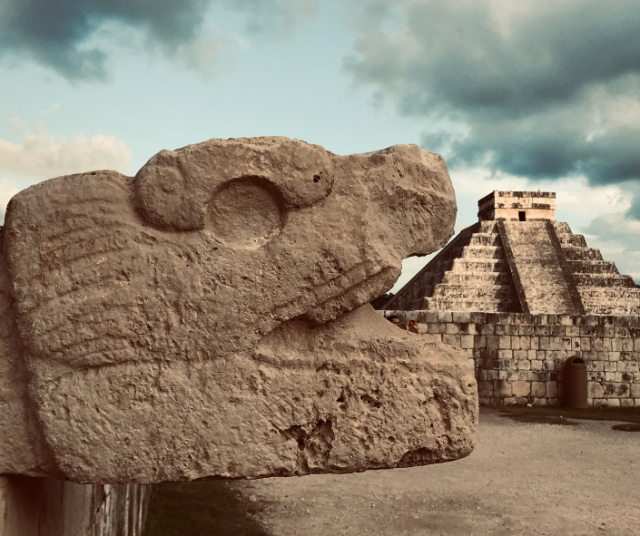The Mayan culture is one of the most intriguing and enigmatic civilizations in human history. Over millennia, the Mayans developed a society rich in knowledge, art, and spirituality in what we know today as Mexico, Belize, Guatemala, Honduras, and El Salvador. His legacy endures today, leaving deep traces in archaeology, astronomy, mathematics, writing and spirituality.
Historical background
The historical background of the Mayan culture dates back to the dawn of humanity in the lands of Mesoamerica, where the roots of this extraordinary civilization arose. Around 2000 BC, in the region encompassing what we now know as southeastern Mexico, Belize, Guatemala, Honduras, and El Salvador, a culture flourished that would lay the foundations for what would become the Mayan civilization.
Initially, the Mayans were an agricultural people who primarily grew corn, which would become the staple of their diet and a cornerstone of their culture. These early communities lived in villages and developed rudimentary systems of agriculture and trade. However, as time progressed, settlements began to grow and organize into larger and more complex communities.
One of the most notable aspects of early Mayan culture was its ability to adapt to its environment. They took advantage of the region's geographic diversity, ranging from rainforests to mountainous highlands, and developed agricultural systems that allowed them to thrive in diverse landscapes. This agricultural ingenuity, along with their ability to take advantage of natural resources, was a crucial factor in the development of their society.
Political and Social Organization
Mayan society was highly organized. Each city-state was ruled by a supreme leader known as "halach uinic", and the cities were often in conflict over control of territory. The Mayans also developed a system of nobility, priests, farmers, and slaves, resulting in a hierarchical social structure.
Writing and Mayan Language
The Mayans developed one of the most sophisticated writing systems of the pre-Columbian civilizations of America. Their writing included glyphs that represented sounds, words, and concepts. Although long considered undecipherable, advances in Mayan epigraphy have allowed the translation of many of their texts, revealing details about their history and religion.
Achievements in Mathematics and Astronomy
The Mayans were accomplished mathematicians and astronomers. They developed a vigesimal number system (based on 20) and created a precise calendar, the Mayan calendar, which followed the lunar and solar cycles with great accuracy. They also observed and recorded astronomical phenomena such as eclipses and the movement of the planets, which demonstrates a deep knowledge of the stars.
Mayan Architecture and Cities
Mayan architecture is one of the most recognized in Mesoamerica. They built elaborate cities with temples, palaces, and astronomical observatories. Tikal, Palenque and Copan are notable examples of Mayan cities that can still be visited today. Their limestone structures carved with intricate reliefs and sculptures are testament to their construction skill.
Mayan Art and Culture
Mayan art is known for its beauty and detail. They created decorative pottery, colorful textiles, and elaborate jade jewelry. His mural paintings at sites such as Bonampak depict scenes of daily life and religious rituals. Additionally, jade funerary masks, such as that of Pakal the Great, are impressive examples of his funerary art.
Mayan Religion and Mythology
The Mayan religion was deeply rooted in their daily life and centered on the worship of gods such as Kukulkan (Quetzalcoatl in Aztec mythology) and Chaac, the god of rain. The Mayans believed in life after death and performed elaborate funerary rituals that included burials and offerings.
Decline and Abandonment of the Mayan Cities
Despite their cultural achievements, Mayan cities began to decline around the 9th century AD. Various theories have been proposed for the causes of their decline, including war, overexploitation of natural resources, and drought. Many of the Mayan cities were abandoned, and the classical Mayan civilization came to an end.
Lasting Legacy of the Mayans
Despite the collapse of their cities, the Mayans did not completely disappear. Their descendants continue to live in the regions where their civilization flourished, and maintain their cultural traditions, language, and ways of life. Additionally, the mathematical and astronomical knowledge of the Mayans influenced later civilizations in Mesoamerica, such as the Aztecs and Incas.
Rediscovery and Modern Recognition
The Mayan civilization received new attention in the 19th century with the archaeological exploration of sites such as Copan and Tikal. Researchers and archaeologists have unearthed treasures of Mayan knowledge and art, and Mayan culture has once again been valued and appreciated around the world.
Tourism and Preservation
The relationship between tourism and the preservation of Mayan culture is a fundamental issue today. As interest in this ancient civilization has grown, Mayan archaeological sites have become popular tourist destinations in Mesoamerica. This has posed unique challenges and opportunities in terms of conservation and protection of cultural heritage.
Mayan archaeological sites, such as Tikal in Guatemala and Chichen Itzá in Mexico, attract thousands of visitors from around the world each year. This tourism can be beneficial, contributing to the local and global economy, promoting knowledge and appreciation of Mayan culture, and funding conservation projects. However, it also presents significant threats to the preservation of these historic sites.
Increased tourism carries risks of physical deterioration due to constant exposure and manipulation of ancient structures. Erosion, vandalism and looting are real concerns at some sites. Additionally, the influx of visitors can cause considerable stress on infrastructure, such as roads and trails, and negatively impact the surrounding natural environment.
To address these challenges, preservation measures have been implemented at many Mayan sites. Restricted zones have been established to protect sensitive areas, and strict rules for visitor behavior have been implemented. Archaeologists and conservationists work on the restoration and conservation of ancient structures, using advanced techniques to preserve the authenticity of the sites.
Additionally, efforts are focused on visitor education and awareness. Programs have been developed to inform tourists about the importance of preserving cultural and natural heritage. This includes the promotion of sustainable tourism, which seeks to minimize negative environmental and cultural impacts while maximizing benefits to local communities.
